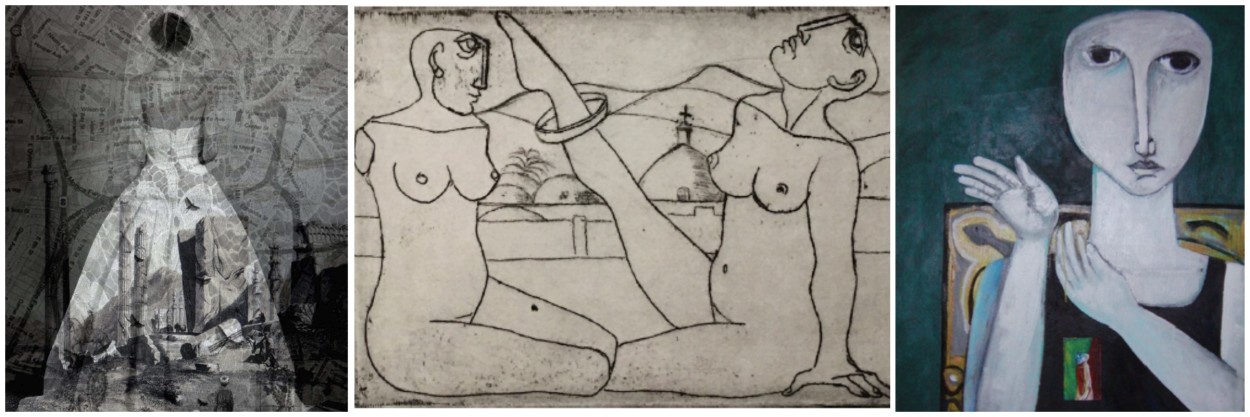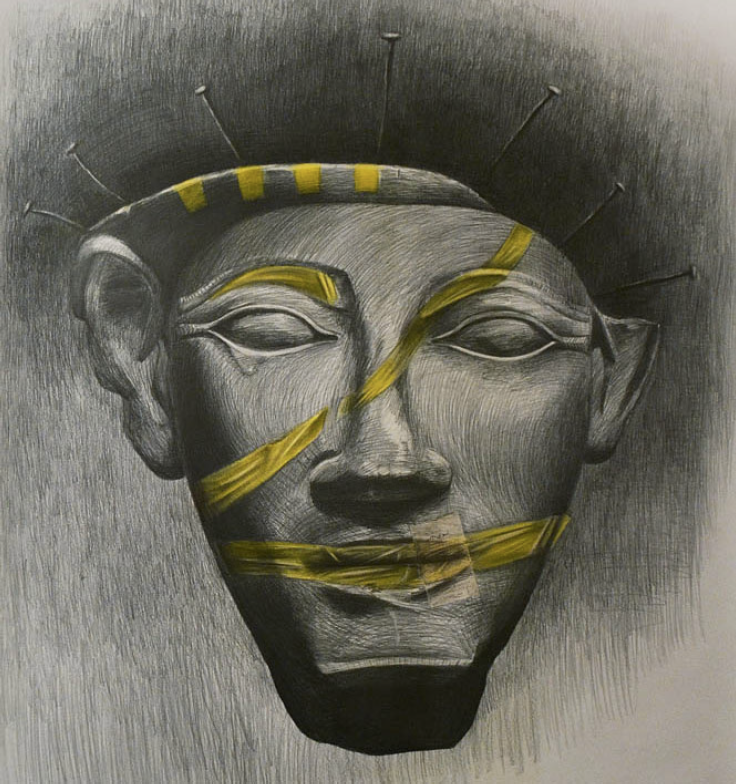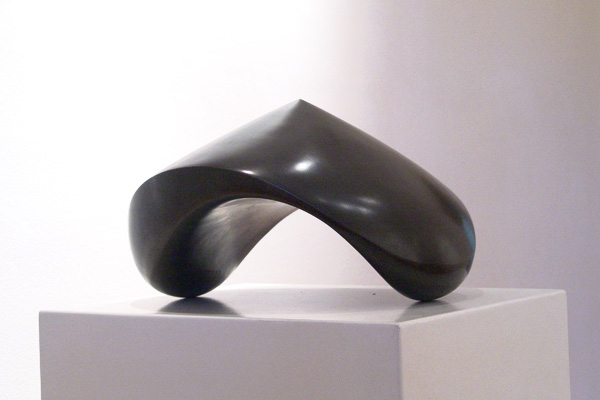SYRA ARTS & THE UNTITLED SPACE
present
Debunking Orientalism
A Group Show of Contemporary Egyptian Art
Curated by Nagla Samir
VIP PREVIEW
Tuesday, April 12th
5-6pm
OPENING RECEPTION
Tuesday, April 12th
6-8pm
THE UNTITLED SPACE
45 Lispenard Street Unit 1W
NYC 10013
EXHIBITION ON VIEW
April 13 – 16 | 12pm – 6pm
April 17 | 12pm – 4pm

SYRA Arts and The Untitled Space are pleased to present the group show, “Debunking Orientalism,” curated by Nagla Samir and featuring works by emerging and established artists who live and work out of Egypt, from Cairo, Beheira, Sohag and Alexandria. The show will run from April 13th – 17th, 2016. Artists include: Ahmed Morsi, Adel El Siwi, Armen Agop, Essam Darwish, Farouk Hosny, Galila Nawar, Marwa Adel, Mina Nasr, Mohamed Ardash, Muhammad Mahdy, Ramses Marzouk, and Yasser Rostom. Additionally the exhibit will be showcasing jewelry by acclaimed designer Azza Fahmy.
“’Debunking Orientalism’ is an exhibition that aims to create a new vocabulary in the hope of bringing a deeper insight to an old vision of the Eastern world, through Egyptian artists who are finding their own unique language that speaks to the universal humanity… It is important to explore how contemporary Egyptian artists have not only challenged the status quo, but have also expressed a genre of art so unique to the true culture of the Middle East that ‘Orientalism’ as it was constructed as a device of understanding the region, unravels as truly fictitious.”
– Curator Nagla Samir
The exhibition offers a window onto a landscape comprised of a multiplicity of approaches, styles and engagements by artists working simultaneously and engaging with various narratives within the art scene in Egypt. In recent years, the art of the region has been subject to a cultural clustering which effectively flattens the varied artistic production by viewing it as contingent upon geopolitical context. Egypt’s long history with Orientalism has subjected it to both internal and external visual paradigms that epistemologically cling to such Eurocentric notions.
The diversity of artists represented in this show celebrates the pluralism and dynamism of the contemporary Egyptian art scene. The works resonate locally and internationally, without necessarily pandering to the model of ‘hybridity,’ which has been a favored mode through which to view regional art – as operating in a liminal space between East and West. Some of the artists work out of Egypt, whilst some engage directly with their surroundings, and others create an altogether unique visual vernacular.
More recently, awareness has grown, of the value in acknowledging the multiple changes taking place over different timelines around the world. This exhibition hopes to further that awareness and challenge perceptions about art in Egypt that still stem from Orientalist impulses.

ABOUT SYRA ARTS:
Since its establishment in 2011 by Sylvia Van Vliet Ragheb and Randa Fahmy Aboul-Nasr, Syra Arts has been dedicated to bringing cutting-edge artists representing the variety and depth of the Middle East to art lovers and discerning collectors. By introducing artists who express their strong roots in art that transcends cultural barriers, Syra Arts is at the forefront of conversations that pave the way to understanding and appreciating the exciting and forever changing region.
“Debunking Orientalism” is an exhibition in which Syra Arts teams up with renowned curator Nagla Samir, aiming to give art enthusiasts an opportunity to explore the many layers of Egyptian identity and to travel through time unveiling different styles and mediums. ‘Debunking Orientalism’ hopes to challenge all preconceived notions and perceptions one might have on Oriental art; and to engage in discussions on creativity of expression and how it is affected by race, religion, creed and politics.
For more information about the exhibition or to request images, please contact Sylvia Van Vliet Ragheb at sylvia@syra-arts.com
ABOUT THE ARTISTS:
Ahmed Morsi
Ahmed Morsi’s surreal landscapes and portraits juxtapose features from Coptic, Pharaonic and modern folk Egyptian visual languages, offering up new narratives and creating a visual dialogue with his forerunners from the Egyptian Surrealist Group (founded in the late 1930s). Morsi was born in Alexandria, Egypt in 1930. In 1954, he graduated from the University of Alexandria, Faculty of Arts with a major in English Literature. During the years 1952-53, he studied art in the studio of the Italian master Antonio Becci, whose former students included Seif Wanly, in Alexandria. Early on, Ahmed Morsi was initiated into Alexandria’s literary society as well as the city’s very own rising group of artists. By his early twenties, he was participating in group shows with Egypt’s most notable modern artists, among them A Al Gazzar, H El Telmisani, I Massouda, F Kamel, H Nada and M Moussa. In 1974, Ahmed Morsi moved to New York City, where he continues to paint, write and critique form his Manhattan home.
Adel El Siwi was born in Beheira in the early fifties. A self taught painter, he initially studied medicine at Cairo University. Like many Egyptian intellectuals, he immigrated to Europe in the late seventies, only to return to Cairo 1990, where he currently resides and works. Internationally renowned and receiving numerous awards including the 1997 Venice Biennale, Adel El Siwi is one of the most established and influential painters of his generation.
Armen Agop was born and raised in Egypt, he is deeply rooted in his familial Armenian culture – a population nearly wiped out 100 years ago – and is currently residing in Italy. His sculptures have been often described as futuristic UFOs, and yet ancient, spiritual and meditative. Agop believes that his timeless sculptures offer a more humanist and Sufi approach, one that evolves around cordial existence of both work and viewer in a shared experience.
It was culturally and socially unacceptable for a young lady from the conservative Upper Egypt state of Sohag, with a Fine Arts degree and a respectable job in the government to work as an apprentice in a workshop. Although deemed crazy by colleagues and friends, Azza Fahmy’s goal was crystal clear; for she had found her niche in life. In constant search for inspiration, Azza, aka “the First Lady of Cultural Jewelry” explores conceptual and aesthetic values of Ancient Egyptian, Coptic, Islamic, Nubian, African and folkloric heritage. Locally and internationally celebrated, she has successfully transformed the concept of jewelry making from a craft to an art.
Darwish is an award-wining artist who excels in working with granite, bronze and iron and offers a full scope of experimentation during his three decades of art practice. Whether monumental granite sculptures or abstract figurative pieces, his works are reminiscent of the Pharaonic traditions. His whimsical bronze creations- although inspired by his ancient heritage sprightly transgress it.
Farouk Hosny
Farouk Hosny’s gestural, vibrant palette speaks the universal language of formalist abstraction in a cultural response to Western abstract expressionism. Hosny was born in Alexandria in the early 1938’s. He graduated from the Alexandria Academy of Arts in 1964. He was appointed upon graduation as director of Anfoushy Cultural Palace in Alexandria and later moved to Paris as cultural attaché in charge of the Egyptian cultural center there. Hosny was honored at an early age to assume the prestigious position of handling the Egyptian academy of arts in Rome. Upon his great success in the Rome Academy, he was chosen as the Minister of Culture of Egypt until his retirement in 2011. His works have been exhibited in several international museums including the Metropolitan Museum, Houston Museum of Fine Arts, the National Museum of Vienna, le Vittoriano Museum in Rome, Carrousel du Louvre in Paris, Tokyo Art Museum, in addition to several Arab and Egyptian Museums.
Faces that are about to be forgotten are among Galila’s inspirations. In a deliberate attempt to romanticize them, she uses a language reminiscent to that of romantic paintings, yet one that is not far from the ephemeral nature of newsprint. Born in Cairo to a family of filmmakers, Galila’s interest in portraiture lies in the tension between the latent and the manifest; on the one hand the persona that is presented in a pose or captured snapshot, and on another hand the real person behind it.
A single mum, currently residing in the US, Marwa Adel denounced her orthodox family traditions, took off her Islamic head veil “hijjab”, and in her work she still wears the scars as she struggles to shake off years of restrictions imposed by her male-dominated background. She examines the paradoxical facts that face eastern feminism, as it keeps coming in rhetorical countermoves against the constant tides of societal fundamentalism.
An avid observer of the community, Mina Nasr demonstrates the human condition in relation to surrounding circumstances, by reshaping the body according to conceptual and architectural situations. Most of his work is monumental in scope, whether it is a street mural, or confined and framed in a gallery space. Mina represents a generation of social activist artists who helped pave the way for audiences to delve into and appreciate contemporary art practices.
Mohamed Ardash unfolds his inspiration to the fluid enigmatic world of stylized species and characters echoing society as a whole, swept and blurred by compulsive abstraction that dubs layers of dynamic narratives.
Muhammad Mahdy
Muhammad Mahdy’s calligraphic, gestural paintings push beyond the boundaries of the textual, reorienting our attention to the aesthetic qualities of script, no longer as a vehicle for meaning but rather as an expressive mode in itself. In spite of the fact that the words and phrases in Mahdi’s calligraphic artworks are literarily meaningful, his main concern is the philosophy of movement in letters, which reflects a complementary conception of beauty beyond legibility. He exceeds the typical philosophy behind the Arabic calligraphy towards a Zen holistic approach.
Ramses Marzouk seeks to decipher the relationship between the body and the elements of nature in an attempt to discover how they compliment or extend each other. A director of photography who has collected more than 50 international and national awards during his 40-year career in Egyptian Cinema, Ramses constantly looks into the infinitesimal detail and collects all the bits and pieces he discovers to make one aware of each personality taken in its totality.
Working with pen and ink, Yassar Rostom’s rich imagery and contrasting backgrounds are packed with bizarre scenes and emotional symbolism. A rising star in the contemporary art scene, his work is conceptually edgy and technically stunning.

ABOUT THE CURATOR:
Coming from a graphic design background, Nagla Samir has worked as a Creative Director while pursuing her post-graduate studies. She holds an MFA and a Ph.D. in Visual Communication, and has been teaching since 2002.
In 2006 – 2009 she founded and directed “Passage 35”; a platform concerned with scouting for and endorsing young talent. During this time she contributed to and co-curated numerous exhibitions and cultural events. In 2008 she curated “IMAFY”, an international forum for media art for youth in Cairo. In 2010 after curating the group exhibition “A Survival Guide” for the Sharjah Gallery at the American University in Cairo, Nagla was appointed as its Director.
Among her curatorial projects are: “Liberation: A Process Review” 2012, for Havremagazinet, Sweden, and “Beyond Classification” 2015, featuring eight Egyptian women photographers and video artists at Sewanee University Art Gallery in Tennessee and the Second St. Gallery in Virginia. She has also served as Project Manager for “Bearing Witness: Stories of Ordinary People Living Extraordinary Times” for Medrar, Cairo 2012, in collaboration with the Bronx Museum and the US State Department and “Generator: The 6th Cairo International Festival for Video Art and Experimental Film”, Cairo 2014.
Samir currently pursues a career as Professor of Graphic Design at the American University in Cairo (AUC), during which she has curated “Helmi El Touni: Design Retrospective” for Sharjah Gallery in 2014, “Nuqat” in Kuwait in 2015, and “Heyya Fawda: The Chaos” in 2015. She is a member of the curatorial team of the “Egyptian Surrealists in Global Perspective” conference and exhibition, which is organized by the Institute of Comparative Modernities in Cornell University, in collaboration with Sharjah Art Foundation and AUC, Egypt.
Nagla also leads a parallel career as a media artist. She has participated in numerous local and international art shows, including solo exhibitions in 2005, 2007 and 2010. She has received awards for her work, including the Prize of the Biennial for Mediterranean Countries in 2007.

